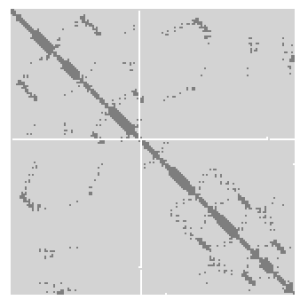Mathematical Model and Inference
Mathematical Model
The basis of DCA is a statistical model for the variability within a set of phylogenetically related biological sequences. When fitted to a multiple sequence alignment (MSA) of sequences of length , the model defines a probability for all possible sequences of the same length. [1] This probability can be interpreted as the probability that the sequence in question belongs to the same class of sequences as the ones in the MSA, for example the class of all protein sequences belonging to a specific protein family.
We denote a sequence by , with the being categorical variables representing the monomers of the sequence (if the sequences are for example aligned amino acid sequences of proteins of a protein family, the take as values any of the 20 standard amino acids). The probability of a sequence within a model is then defined as
where
- are sets of real numbers representing the parameters of the model (more below)
- is a normalization constant (a real number) to ensure
The parameters depend on one position and the symbol at this position. They are usually called fields [1] and represent the propensity of symbol to be found at a certain position. The parameters depend on pairs of positions and the symbols at these positions. They are usually called couplings [1] and represent an interaction, i.e. a term quantifying how compatible the symbols at both positions are with each other. The model is fully connected, so there are interactions between all pairs of positions. The model can be seen as a generalization of the Ising model, with spins not only taking two values, but any value from a given finite alphabet. In fact, when the size of the alphabet is 2, the model reduces to the Ising model. Since it is also reminiscent of the model of the same name, it is often called Potts model. [19]
Even knowing the probabilities of all sequences does not determine the parameters uniquely. For example, a simple transformation of the parameters
for any set of real numbers leaves the probabilities the same. The likelihood function is invariant under such transformations as well, so the data cannot be used to fix these degrees of freedom (although a prior on the parameters might do so [3] ).
A convention often found in literature [3] [20] is to fix these degrees of freedom such that the Frobenius norm of the coupling matrix
is minimized (independently for every pair of positions and ).
Maximum Entropy Derivation
To justify the Potts model, it is often noted that it can be derived following a maximum entropy principle: [21] For a given set of sample covariances and frequencies, the Potts model represents the distribution with the maximal Shannon entropy of all distributions reproducing those covariances and frequencies. For a multiple sequence alignment, the sample covariances are defined as
- ,
where is the frequency of finding symbols and at positions and in the same sequence in the MSA, and the frequency of finding symbol at position . The Potts model is then the unique distribution that maximizes the functional
The first term in the functional is the Shannon entropy of the distribution. The are Lagrange multipliers to ensure , with being the marginal probability to find symbols at positions . The Lagrange multiplier ensures normalization. Maximizing this functional and identifying
leads to the Potts model above. This procedure only gives the functional form of the Potts model, while the numerical values of the Lagrange multipliers (identified with the parameters) still have to be determined by fitting the model to the data.
Direct Couplings and Indirect Correlation
The central point of DCA is to interpret the (which can be represented as a matrix if there are possible symbols) as direct couplings. If two positions are under joint evolutionary pressure (for example to maintain a structural bond), one might expect these couplings to be large because only sequences with fitting pairs of symbols should have a significant probability. On the other hand, a large correlation between two positions does not necessarily mean that the couplings are large, since large couplings between e.g. positions and might lead to large correlations between positions and , mediated by position . [1] In fact, such indirect correlations have been implicated in the high false positive rate when inferring protein residue contacts using correlation measures like mutual information. [22]
Inference
The inference of the Potts model on a multiple sequence alignment (MSA) using maximum likelihood estimation is usually computationally intractable, because one needs to calculate the normalization constant , which is for sequence length and possible symbols a sum of terms (which means for example for a small protein domain family with 30 positions terms). Therefore, numerous approximations and alternatives have been developed:
- mpDCA [23] (inference based on message passing/belief propagation)
- mfDCA [1] (inference based on a mean-field approximation)
- gaussDCA [20] (inference based on a Gaussian approximation)
- plmDCA [3] (inference based on pseudo-likelihoods)
- Adaptive Cluster Expansion [24]
All of these methods lead to some form of estimate for the set of parameters maximizing the likelihood of the MSA. Many of them include regularization or prior terms to ensure a well-posed problem or promote a sparse solution.














































